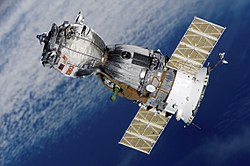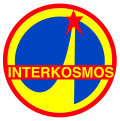 | |
| COSPAR ID | 1988-075A |
|---|---|
| SATCAT no. | 19443 |
| Mission duration | 114 days, 5 hours, 33 minutes, 49 seconds |
| Orbits completed | ~1,840 |
| Spacecraft properties | |
| Spacecraft | Soyuz 7K-STM No. 56 |
| Spacecraft type | Soyuz-TM |
| Manufacturer | NPO Energia |
| Launch mass | 7,070 kilograms (15,590 lb) |
| Crew | |
| Crew size | 3 |
| Launching | Vladimir Lyakhov Valeri Polyakov Abdul Mohmand |
| Landing | Vladimir Titov Musa Manarov Jean-Loup Chrétien |
| Callsign | Прото́н (Proton) |
| Start of mission | |
| Launch date | 29 August 1988, 04:23:11 UTC [1] |
| Rocket | Soyuz-U2 |
| Launch site | Baikonur 1/5 |
| End of mission | |
| Landing date | 21 December 1988, 09:57:00 UTC |
| Landing site | [1] 160 kilometres (99 mi) SE of Dzhezkazgan |
| Orbital parameters | |
| Reference system | Geocentric |
| Regime | Low Earth |
| Docking with Mir | |
| Docking date | 31 August 1988, 05:40:44 UTC |
| Undocking date | 21 December 1988, 02:32:54 UTC |
 Soyuz programme (Crewed missions) | |
Soyuz TM-6 was a crewed Soyuz spaceflight to Mir . [2] It was launched on 29 August 1988, at 04:23:11 UTC, for the station's third long-duration expedition, Mir EO-3. The three-person crew that was launched consisted of Research Doctor Valeri Polyakov, who became part of the EO-3 crew, as well as the two crew members of the week-long mission Mir EP-3, which included the first ever Afghan cosmonaut, Abdul Ahad Mohmand. [3]
Contents
On September 8, Soyuz TM-6 was undocked from Mir's Kvant port and redocked onto the Mir Base Block's port. [4] It remained there until December, when it brought Titov and Manarov of the EO-3 crew back to Earth. It also landed French astronaut Jean-Loup Chrétien, ending his 25-day-long spaceflight which started with Soyuz TM-7.


